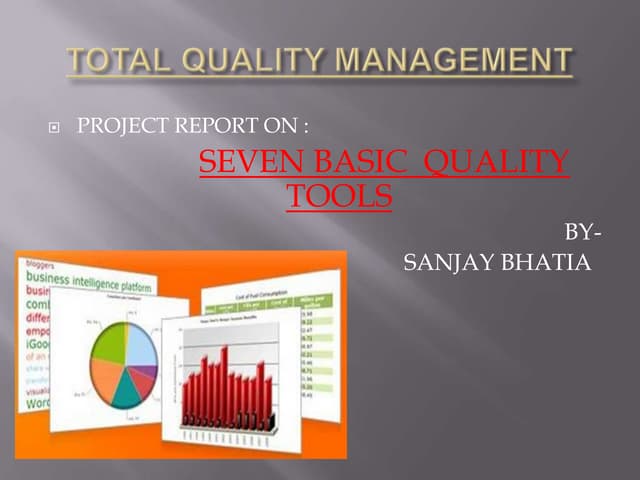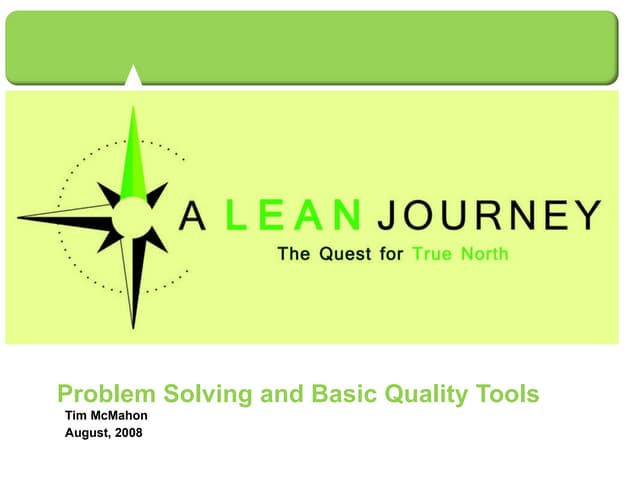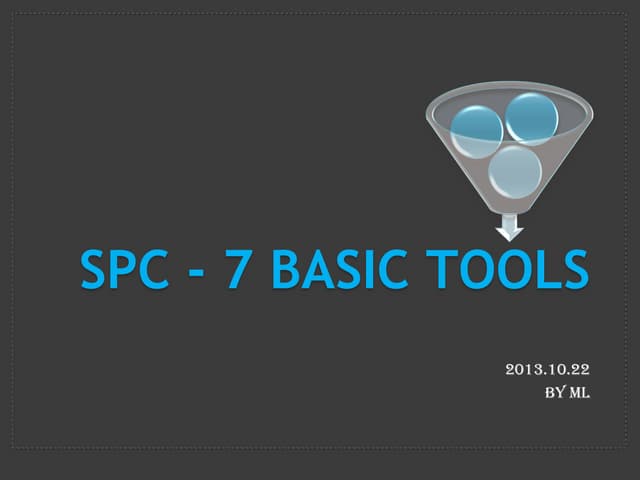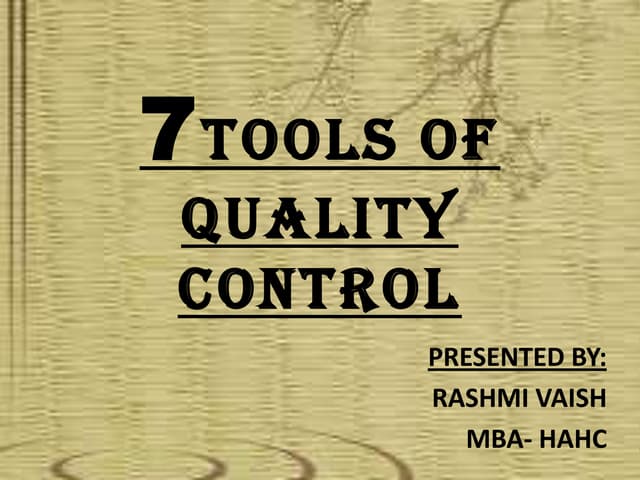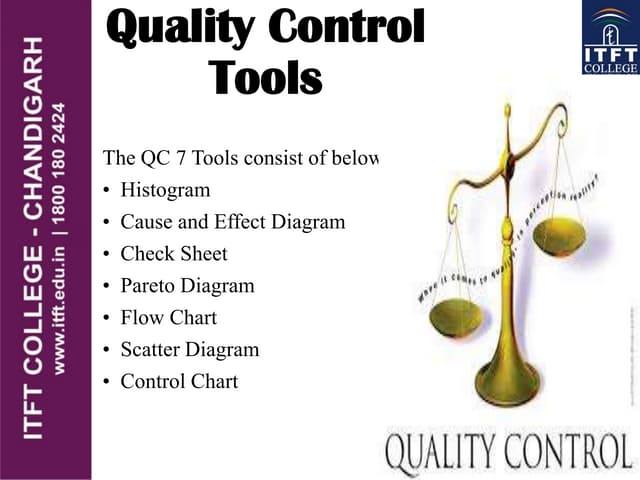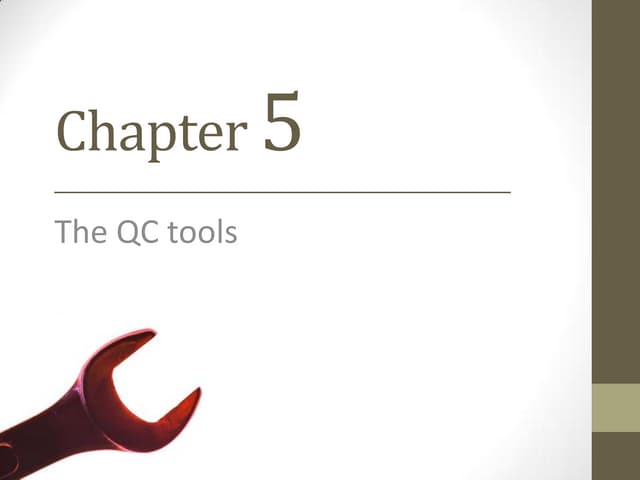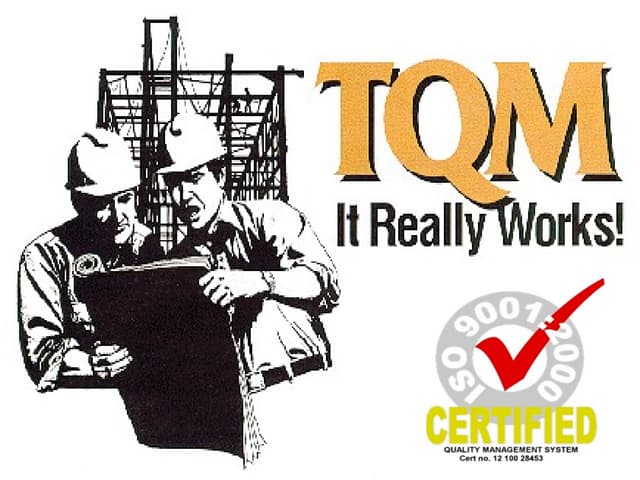Your SlideShare is downloading.
×
×

Saving this for later?
Get the SlideShare app to save on your phone or tablet. Read anywhere, anytime - even offline.
Text the download link to your phone
Standard text messaging rates apply

Like this presentation? Why not share!
-
Seven Basic Tools by Sanjay bhatia 16719 views
-
7 qc toolsTraining pdf by Shakehand with Life 4237 views
-
7 QC Tools by Senthilkumar RM 10685 views
-
The Seven Basic Tools of Quality by Tim McMahon 30217 views
-
Statistical Process Control (SPC) T... by Madeleine Lee 6354 views
-
Seven tools of quality control by rashmi123vaish 9042 views
-
Quality control tools by mmaninderkkaur 2190 views
-
TQM Quality control Tools by Sofie Zelada 9457 views
-
Tools and techniques used in tqm ppt by abhandary 19104 views
-
7 QC TOOLS by Advance Innovatio... 4832 views
-
Total quality management tools and ... by bhushan8233 9588 views
-
Tqm power point by Karen Morales 39507 views
Like this? Share it with your network
Share
7 qc tools training material[1]
48,593
views
views
Published on
-
 Full NameComment goes here.Delete Reply Spam Block
Full NameComment goes here.Delete Reply Spam Block
-
 Naruepon Puangsuntorn , Leader at CH.Auto Parts Co., Ltd.good documentReply
Naruepon Puangsuntorn , Leader at CH.Auto Parts Co., Ltd.good documentReply -
 varinder singh , mechanical engineer with 13 years experience in machine shop manufacturing at matchwell engineering compamy , jalandhargood jobReply
varinder singh , mechanical engineer with 13 years experience in machine shop manufacturing at matchwell engineering compamy , jalandhargood jobReply -
 rohithnganigood. simple and effectiveReply
rohithnganigood. simple and effectiveReply -
 Vinay Chawla at CEAT LimitedGood presentation ... Quite easy to understandReply
Vinay Chawla at CEAT LimitedGood presentation ... Quite easy to understandReply -
 Om Prakash Agrawal , Consultant at OCL India Ltd.quite helpful.Reply
Om Prakash Agrawal , Consultant at OCL India Ltd.quite helpful.Reply
Show More
No Downloads
Views
Total Views
48,593
On Slideshare
0
From Embeds
0
Number of Embeds
3
Actions
Shares
53
Downloads
2,283
Comments
11
Likes
15
Embeds
0
No embeds
No notes for slide
Transcript
- 1. Training module on7 QC Tools7 Q C Tools 1
- 2. What are 7 QC Tools ?QC tools are the means for Colleting data ,analyzing data , identifying root causes andmeasuring the results.THESE TOOLS ARE RELATED TONumerical DATA processingUSER HAS TO DEVELOP THE SOLUTION & IMPLEMENT7 Q C Tools 2
- 3. 7 QC TOOLS• Pareto Diagram• Stratification•Scatter Diagram•Cause and Effect Diagram•Histogram•Check Sheet•Control Chart/Graph 7 Q C Tools 3
- 4. Application of QC tools in Problem Solving Graphs Check Stratifi Pareto Cause & Histogra Scatter Control sheet cation Diagra Effect m Diagram Chart m DiagramIdentification ofproblemDefining theproblemRecord of factsDetecting causes ofproblemDevelopImprovementmethod( Solution )ImplementationEvaluation of resultProcess control( Standardization ) 7 Q C Tools 4
- 5. Pareto Diagram1. What is Pareto diagram ?A Pareto diagram is a combination of bar and line graphs ofaccumulated data, where data associated with a problem(e.g., a defect found, mechanical failure, or a complaintfrom a customer) are divided into smaller groups by causeor by phenomenon and sorted, for example, by the numberof occurrences or the amount of money involved. (Thename “Pareto” came from an Italian mathematician whocreated the diagram.) 7 Q C Tools 5
- 6. Pareto Diagram2. When is it used and what results will be obtained? Please refer to the table on next slide for the usage and benefits of a Pareto diagram. It is mainly used to prioritize matters, and because of its easiness of use, the diagram is used in a wide variety of fields. 7 Q C Tools 6
- 7. Pareto Diagram Method Usage Result Used to identify a problem. Allows clarification of Pareto Diagram Used to identify the cause of important tasks. (No. of Occurrences) a problem. Allows identification of Used to review the effects of a starting point (which an action to be taken. task to start with). Allows projection of Used to prioritize actions. the effects of a measure (Used during phases to to be taken monitor the situation, analyze causes, and review effectiveness of an action.) 7 Q C Tools 7
- 8. Pareto Diagram Example Assessment using Pareto Confirmation of Effect diagram (prioritization) (Comparison) To identify a course of action to be emphasized Frequently used to check using a variety of data. the effect of an improvement. Details of “ A” Improved 7 Q C Tools 8
- 9. Stratification1. What is Stratification ? Stratification means to “divide the whole into smaller portions according to certain criteria.” In case of quality control, stratification generally means to divide data into several groups according to common factors or tendencies (e.g., type of defect and cause of defect). Dividing into groups “fosters understanding of a situation.” This represents the basic principle of quality control. 7 Q C Tools 9
- 10. Stratification2. When is it used and what results will be obtained? The “common and basic principle” of quality control is stratification, i.e., to think a matter out by breaking it into smaller portions. Stratification has a number of useful purposes. The table below shows only a few examples of these purposes. 7 Q C Tools 10
- 11. Stratification Method Usage ResultGrouping by day, •Used to observe variations •Allows observationtime, place, among strata.worker, or •Used to identify the of variations amongprocess strata. relationship between cause •By performing a Number of Units and effect. •Used to identify a purpose cause analysis using X ★★★★★★★ the stratified data, Y △△△△ and means to serve the the following can be purpose Z ○○○ [Used during phases to monitor accomplished. the situation, analyze causes, 1.Identification and control of a review effectiveness of an action, problem perform standardization, and 2.“Division of data (obtained by implement a selected control using each QC tool) into several measure.] groups” 7 Q C Tools 11
- 12. Stratification Item Method of Stratification Hour, a.m., p.m., immediately after start of work,Elapse of time shift, daytime, nighttime, day, week, month Worker, age, male, female, years of experience,Variations among workers shift, team, newly employed, experienced worker Processing method, work method, workingVariations among work conditions (temperature, pressure, and speed),methods temperatureVariations among Measurement tool, person performingmeasurement/inspection measurement, method of measurement, inspector,methods sampling, place of inspection 7 Q C Tools 12
- 13. Scatter Diagram1. What is Scatter Diagram ? A scatter diagram is used to “examine the relationship between the two, paired, interrelated data types, ” such as “height and weight of a person.” A scatter diagram provides a means to find whether or not these two data types are interrelated. It is also utilized to determine how closely they are related to identify a problem point that should be controlled or improved. 7 Q C Tools 13
- 14. Scatter Diagram2. When is it used and what results will be obtained? The table on next slide shows some examples of scatter diagram’s usage. If, for example, there is a relationship where “an increase in the number of rotations (x) causes an increase in abrasion (y),” there exists “positive correlation.” If, on the other hand, the existence of a relationship where “an increase in the number of rotations (x) causes a decline in abrasion (y)” indicates that there is “negative correlation.” 7 Q C Tools 14
- 15. Scatter Diagram Method Usage Result •Used to identify a relationship •Can identify cause Scatter Diagram between two matters. yAxis •Used to identify a relationship and effect relation. Abrasion between two matters and establish •Can understand the countermeasures based on their cause and effect relation. relationship x Axis Example Usage between two Number of Rotations 1.Relationship between thermal results. treatment temperature of a steel material and its tensile strengths 2.Relationship between visit made by a salesman and volume of sales 3.Relationship between the number of persons visiting a department store and volume of sales 4 Others [Used during phases to monitor the situation, analyze causes, and review effectiveness of an action.] 7 Q C Tools 15
- 16. Scatter Diagram yAxisAbrasion (micron) x Axis Number of Rotations 7 Q C Tools 16
- 17. Cause & Effect Diagram1. What is Cause & effect Diagram ?A cause and effect diagram is “a fish-bone diagram thatpresents a systematic representation of the relationshipbetween the effect (result) and affecting factors (causes).”Solving a problem in a scientific manner requiresclarification of a cause and effect relationship, where theeffect (e.g., the result of work) varies according to factors(e.g., facilities and machines used, method of work,workers, and materials and parts used). To obtain a goodwork result, we must identify the effects of various factorsand develop measures to improve the result accordingly. 7 Q C Tools 17
- 18. Cause & Effect Diagram2. When is it used and what results will be obtained? A cause and effect diagram is mainly used to study the cause of a certain matter. As mentioned above, the use of a cause and effect diagram allows clarification of causal relation for efficient problem solving. It is also effective in assessing measures developed and can be applied to other fields according to your needs. 7 Q C Tools 18
- 19. Cause & Effect Diagram Method Usage Result Used when Can obtain a clear overall picture of causal Cause and Effect clarifying a cause relation. (A change in Diagram Machine Man and effect the cause triggers a relationship.[Used variation in the Effect during a phase to result.)○ Can clarify analyze causes.] the cause and effect Material Method relationship. Cause (4M’s) Result (Controlled State) Used to develop Can list up all causes countermeasures. to identify important causes. [Used during a phase to plan countermeasures.] Can determine the direction of action (countermeasure). 7 Q C Tools 19
- 20. Cause & Effect Diagram Mechanism of Quality of Copying Machine Copying Paper Malfunction of Running out Smudges on the the roller of stock Many Copying Errors! copied surface Printing too Too thin Internal devices not lightly working smoothly Dampened Folded Deterioration of Error in performance due Keyboard handling placement of Dirt on the to high error paper (setting glass temperatures its face up) surface Error in selecting a Dust scale of reduction Error in Nicotine- selecting stained shading User Surrounding Environment 7 Q C Tools 20
- 21. Histogram1. What is Histogram ? When creating a histogram, “a range of data is divided into smaller sections having a uniform span,and the number of data contained in each section (the number of occurrences) is counted to develop a frequency distribution table.” Then, “a graph is formed from this table by using vertical bars, each having the height proportional to the number of occurrences in each section.” 7 Q C Tools 21
- 22. Histogram2. When is it used and what results will be obtained? A histogram is mainly used to analyze a process by examining the location of the mean value in the graph or degree of variations, to find a problem point that needs to be improved. Its other applications are listed in the table below. 7 Q C Tools 22
- 23. Histogram Method Usage Result •Used to assess the actual conditions. •Can identify the Histogram •Used to analyze a process to location of the mean Standard Range identify a problem point that needs (central) value or to be improved by finding the degree of variations. location of the mean value or •Can find out the scope degree of variations in the graph. •Used to examine that the target of a defect by inserting X Axis (Values Actually quality is maintained throughout standard values. Range of Variations Measured) the process. •Can identify the •Others condition of [Used during phases to distribution (e.g., monitor the situation, analyze whether there is an causes, and review isolated, extreme effectiveness of an action.] value). 7 Q C Tools 23
- 24. HistogramFrequency Distribution Table Standard StandardCutting Length of Steel Wire] Lower Limit Upper Limit (Standard: 255± 5 mm) Product Section Mean Frequency Marking Occurrences Standard Value [Histogram of Cutting Length of Steel Wire] 7 Q C Tools 24
- 25. Check Sheet1. What is Check sheet ?A check sheet is “a sheet designed in advance to allow easycollection and aggregation of data.” By just entering checkmarks on a check sheet, data can be collected to extractnecessary information, or a thorough inspection can beperformed in an efficient manner, eliminating a possibilityof skipping any of the required inspection items.A check sheet is also effective in performing stratification(categorization). 7 Q C Tools 25
- 26. Check Sheet2. When is it used and what results will be obtained? Please refer to the table on next slide for the usage and benefits of a check sheet. It is frequently used in daily business operations, often not specifically for QC purposes. 7 Q C Tools 26
- 27. Check Sheet Method Usage Result Ensures collection of Check Sheet Used to collect required data. DayProcess data. Allows a thorough Process 1 Used when inspection of all check Process 2 items. Process 3 performing a thorough Can understand inspection. Used during phases to monitor tendencies and the situation, analyze causes, variations. review effectiveness of an Can record required action, perform data. standardization, and implement a selected control measure 7 Q C Tools 27
- 28. Check Sheet A check sheet used to identify defects Date Total Defect Vertical Scratch Scratch Dent 7 Q C Tools 28
- 29. Control Chart (Control Chart / Graph 1)1. What is Control Chart ?A control chart is used to examine a process to see ifit is stable or to maintain the stability of a process.This method is often used to analyze a process. Todo so, a chart is created from data collected for acertain period of time, and dots plotted on the chartare examined to see how they are distributed or if theyare within the established control limit. After someactions are taken to control and standardize variousfactors, this method is also used to examine if aprocess is stabilized by these actions, and if so, tokeep the process in a stable state. 7 Q C Tools 29
- 30. Control Chart2. When is it used and what results will be obtained? There are two types of control charts: one used for managerial purposes and the other for analytical purposes. A control chart is used to identify dots that are outside the control limit, which indicate some anomalies in a process. In addition, seven consecutive dots showing values that are below or above the mean (central) value, or an increment or a decline represented by seven consecutive dots also indicate “a problem in a process.” We need to examine what has caused such a tendency or an increment/decline. 7 Q C Tools 30
- 31. Control Chart Method Usage Result Used to observe a Can identify a change Control Chart caused by elapse of change caused by time. elapse of time. Can judge the [Used during phases to process if it is in its monitor the situation, normal state or there x-R Control Chart analyze causes, review are some anomalies effectiveness of an by examining the dots action, perform plotted on the chart. standardization, and implement a selected In the example “x bar ” -R control chart, “X bar” control measure represents the central value, while “R” indicates the range. Control Chart for Managerial Purposes: Extends the line indicating the control limit used for analytical purposes to plot data obtained daily to keep a process in a good state. Control Chart for Analytical Purposes: Examines a process if it is in a controlled state by collecting data for a certain period of time. If the process is not controlled, a survey is performed to identify its cause and develop countermeasures. 7 Q C Tools 31
- 32. Control Chart Examples of Values Represented by Dots Values above the control limit represented by seven consecutive dots x- Control Chart A decline represented by seven consecutive dots Group Number 7 Q C Tools 32
- 33. Graph1. What is Graph ? A graph is “a graphical representation of data, which allows a person to understand the meaning of these data at a glance.” Unprocessed data simply represent a list of numbers, and finding certain tendencies or magnitude of situation from these numbers is difficult, sometimes resulting in an interpretational error. A graph is a effective means to monitor or judge the situation, allowing quick and precise understanding of the current or actual situation. A graph is a visual and summarized representation of data that need to be quickly and precisely conveyed to others. 7 Q C Tools 33
- 34. Graph2. When is it used and what results will be obtained? A graph, although it is listed as one of the QC tools, is commonly used in our daily life and is the most familiar means of assessing a situation. 7 Q C Tools 34
- 35. Graph Method Usage Result120 Changes in a time-sequential Can observe changes in100 80 order – line graph a time-sequential order, 60 East ratios, and amounts. 40 20 Amounts – bar graph, etc. 0 A graphs is the most 1st Qtr 2nd Qtr 3rd Qtr 4th Qtr Ratios – pie graph, band frequently used tool to chart, etc. examine the various 4th Qtr 13% 1s t Qtr 13% matters such as those 2nd Qtr 17% (The items listed above are listed on the left. representative examples.) 3rd Qtr 57% 7 Q C Tools 35
- 36. Graph [Bar Graph of Sales] [Band Chart of Expenses] ・Survey Period: Dec. 1999 (¥million) (¥million) ・Prepared by: M/T BeforeSales Chemicals Oils Electricity Taking (430) (200) (170) Actions (Total: ¥8 million) After Chemicals Oils Taking (240) (150) Actions (Total: ¥4.95 million) Sales Iwate Tokyo Osaka Shizuoka Electricity Office (108) 7 Q C Tools 36
- 37. To sum up 7 QC tools (Numerical data ) are used as follow: • Pareto Diagram To identify the current status and issues • Stratification Basic processing performed when collecting data • Scatter Diagram To identify the relationship between two things • Cause and Effect Diagram To identify the cause and effect relationship • Histogram To see the distribution of data • Check Sheet To record data collection • Control Chart/Graph To find out abnormalities and identify the current status 7 Q C Tools 37
- 38. Thank you7 Q C Tools 38
![7 qc tools training material[1]](4%20qc%20tools%20training%20material_soubory/7-qc-tools-training-material1-1-728.jpg)






































